For The Edible Love of Krokus and Smilax
No, that is not a “Walking stick” insect. It is the growing end of a Smilax, a choice wild food.
There used to be a field in west Sanford, Florida, near Lake Monroe and the zoo, that was nearly overrun with growing Smilax every spring. I could get a couple of quarts of tender tips daily over a few weeks, enough for many meals. Cooked like asparagus or green beans, they are excellent, and also edible raw.
The tip grows from the end of the vine and gets tougher as one goes back along the vine. Technically that is called
the meristem stage, that is, the growing part is almost always the most tender because the cells haven’t decided what it is they’re supposed to do, such as get tough and hold up the plant or create an odor or the like. The way to harvest smilax is to go back a foot or so from the end of the vine (more if it is a very large vine, less if small) and see if the vine snaps, breaks clean between your fingers. If not, move closer towards the growing end of the vine and try it again. Where the vine snaps and breaks is the part you can take and eat. Well-watered bull briers (Smilax bona-nox, SMEYE-laxs BON-ah-knocks, that’s SM plus EYE) in a field or on a sunny tree can produce edible shoots a foot long and third of an inch through. Smilax is from the Greek smilakos, meaning twining but there is more to that story. Bona-nox means “good night” and usually refers to plants that bloom at night.) The Spanish called them Zarza parilla, (brier small grape vine) which in English became sarsaparilla, and indeed sarsaparilla used to come from a Smilax.
Often called cat briar or bull briar because of its prickles, Smilax climbs by means of tendrils coming out of the leaf axils. Again, technically, it is not a vine but a “climbing shrub.” I have no idea why someone thinks the distinction between vine and climbing shrub is important Smilax are usually found in a clump on the ground or in a tree. They provide protection and food for over forty different species of birds
and are an important part of the diet for deer, and black bears. Rabbits eat the evergreen leaves and vines, leaving a telltale (tell tail?) 45 degree cut. Beavers eat the roots. Smilax also has a long history with man, most famous perhaps for making sarsaparilla. The roots (actually rhizomes) of several native species can also be processed (and are calorie negative requiring more energy to process than obtained) to produce a dry red powder that can be used as a thickener or to make a juice. Young roots — finger size or smaller — can also be cooked and eaten. While the tips and shoots can be eaten raw a lot of raw ones give me a stomach ache.
Medically, the root powder has been used to treat gout. A Jamaican species contains at least four progesterone class phytosterols. Some herbalists recommend that species for premenstrual issues. In 2001, a U.S. patent application said Smilax steroids had the ability to treat senile dementia, cognitive dysfunction and Alzheimer’s. A U.S. patent awarded in 2003 described Smilax flavonoids as effective in treating autoimmune diseases and inflammatory reactions. Note: These are patents claims in anticipation of clinical trials some distant day proving said claims by further research. So don’t start digging up Smilax roots for self-medication. A 29 Feb 2008 study suggest Smilax root has antiviral action and a 2006 study suggest it is good for liver cancer.
It should be mentioned that early American settlers made a real root beer from the smilax. They would mix root pulp with molasses and parched corn then allowed it to ferment. One variation is to add sassafras root chips, which gives it more of the soft drink root beer flavor. Francis Peyre Porcher wrote during the Civil War in the 1860’s “The root is mixed with molasses and water in an open tub, a few seeds of parched corn or rice are added, and after a slight fermentation it is seasoned with sassafras.”
Can we take an aside here? Francis Peyer Porcher, 1824-1895, was a doctor, professor of medicine, and a botanist. Through his mother’s side, he was a descendant of the botanist Thomas Walter, author of Flora Caroliniana, the first catalog of the flowering plants of South Carolina, published in 1788. Peyer, as he liked to be called, was, as they used to say, well-to-do. He was professionally active in both fields — medicine and botany — when the American Civil War began. Because of the blockade of medical supplies he was ordered to write a field manual for doctors to help them find and make the drugs they needed in the
absence of supplies. His work, Resources of the Southern Fields and Forests, is still a reference and I have an ebook copy of it. It was so popular in his day that newspapers carried excepts of it. His effort was credited with helping the South prolong the war. We are fortunate to have two photographs of him, one presumably around war time and the other when he was again a professor and active in medical circles.
There are about 300 or more species in the genus Smilax and are found in the Eastern half of the United States and Canada, basically east of the Rockies. Fourteen species are found in the southern United States. Smilax gets its name from the Greek myth of Krokus and the nymph Smilax. The story is varied. Here’s one version: Their love affair was tragic and unfulfilled because mortals and nymphs weren’t allowed to love each other. For that indiscretion, the man, Krokus, was turned into the saffron crocus by the goddess Artemis (because she, too, was having an affair with Krokus but as a goddess that was okay.) Smilax, actually woodland nymph, was so heartbroken over Krokus’ reduction down to a flower that Artemis took godly pity on her and turned Smilax into a brambly vine so she and Krokus could forever entwine themselves. There are far less poetic and more naughty versions. Seems it was a popular story thousands of years ago with many variation and interpretations.
Oh, about that field in Sanford: A century ago it was a truck farm producing celery and other vegetables. Then it fell fallow growing Smilax. Now it’s an apartment complex. Dried Smilax root was also used to make pipe bowls (briars). Wooden pipe bowls are made from Erica arborea, a shrub-like tree in the heather family native to the Mediterranean area. However, as the smilax root dries it shrinks dramatically making a pipe tiny, so start with a huge root and don’t fit it out until completely dry.
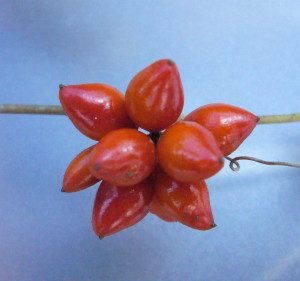
The red berries of Smilax walteri. Photo by Green Deane
Also the growing Smilax tips can become bitter and peppery in hot weather, it is best to boil those. I eat all of the ripe berries except for Smilax walteri (because they are red. I have no evidence they cannot be eaten, I just assume they are red for a reason and I am just following best practices. There is a red-berried smilax on Crete (Smilax aspera) which turn black with age and are not toxic but are considered unpalatable.
Green Deane’s “Itemized” Plant Profile
IDENTIFICATION: A climbing shrub with tuberous roots, knobby white roots tinged with pink, bamboo like stems, more or less thorny, leaves varying with species and on the bush, tiny flowers, five slim petals, fruit round, green turning to black, one small brown seed. Some species have red fruit, edibility of red fruit unreported.
TIME OF YEAR: Starts putting on shoots in February in Florida, later in the season as one moves north. Seeds germinate best after a freeze.
ENVIRONMENT: It grows best in moist woodlands, but can tolerate a lot of dry and is often seen climbing trees. Left on its own with nothing to climb it sometimes creates and brambly shrub. Thicket provides protection for birds.
METHOD OF PREPARATION: Beside making sarsaparilla, the roots can be used in soups or stews, young shoots eaten cooked or in small quantities raw, berries can be eaten both raw and cooked Pounds of roots to pounds of flour is a 10 to one ratio.

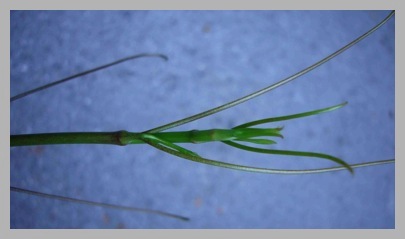
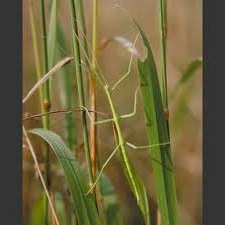
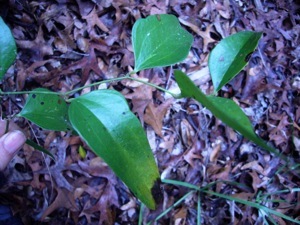
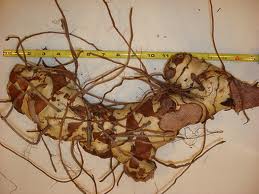
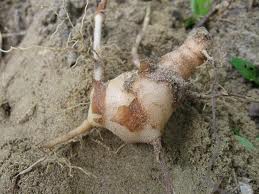
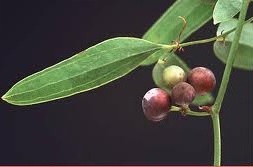


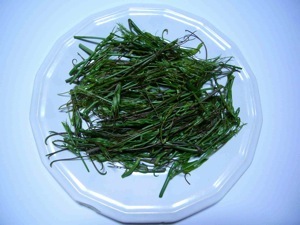

Another warning flag. Gooseberries do not grow in Florida, or at least not here. It has to be something else. As for horsemint… that’s a common term for a wide variety of plants. Monarda punctata is at the end of its season now and is very identifiable. It has small white snap dragon like flowers with purple spots (that’s what punctata means.) It also has large pink bracts, which are extra leaves around the flower head. Again, got a picture? Type Monarda punctata into my search window. I have an article about them on site.
it looked like a cape gooseberry – with the paper covering and all was orange – it was within 20 feet of the easter egg plant – i am sure you know the eggplant they sell at walmart for easter – Solanum melongena – this was once the naval base area – i think some one had a special garden by the lake at one time along this trail – it was there until they sprayed some major weed killer there
I think Physalis are called Cape Gooseberries only in Southern Africa, and then only the cultivated ones. “Gooseberry” to me is a relative of the currant (and kiwi) that grows in northern climates. In North America most Physalis are called Ground Cherries. This is why the botanical name is important.
i have the tips of these plants look exactly like your picture – what i meant to say at the base of the vines where they attached to the big root within 1inch from the root looks pink, see i pulled the vine away from the root and it was pinkish ??
Ah… pink. Pink is different than red. The root of the smilax is large and knobby. It can have a pinkish tinge.
one question that wasnt answered in our discussion – what does the root smell like??????
Potato-ish if anything.
The raw young tips taste like raw field peas to me. Probably better cooked. Did not know the “ripe” berries were edible. Thanks. May try the young roots sometime also. I have seen all three kinds here. Common, Laurel, and Bull.
I’ve got a bunch of what i think is greenbriar in a woods near my house but the berries have two or three seeds in them and they don’t have that funny lookin tip either, so is there some kind of look alike here or is it safe to eat the berries?
I couldn’t say without a picture. There are many different looking species in the genus. They can also have one to three seeds.
Deane,
If we want to make a batch (2l?) of “Zarza parilla,” how owuld you suggest processing the root? Grated, sliced, minced, pulped?
I believe I will be attempting the requivelant of the Civil War recipe unless you happen to have a good one locked away in that head of your’s and you’d like to share. *hint, hint, nudge, nudge*
A wood chipper woud be just about right. The root is really tough. I might me temped to cut the root into small slices on a circular saw then pound the heck out of it make a pulp.
I have dug up roots of at least two species of smilax and they are both thin and wiry, and basically wood. I have heard stories of people making flour with them but I don’t see how this is possible…I whittled the root with a knife and it was wood. It is pretty hard to mistake Smilax for anything due to its distinctive spines and leaves. What do I do to get the flour?
I know what you mean. One has to pound a root into destroyed submission then soak it in water to get its 10% pink starch. Not a calories positive experience. Very young roots — finger size — can been cooked and consumed, however.
What kind of smilax where you digging up roots from? I have smilax rotundifolia and it has thick rhizomes.
Ah… I had no Idea it would be so much work. I might try it with a hammer some time, just to say I’ve tried it, but as a survival skill it doesn’t sound very useful. The book “Survival Skills of the North American Indians” makes it sound easy with, “The various greenbriers were the most important food plants of the Southeast”, and “The root can be chopped for bread or stew.”
I did find a new use for the Smilax berries, however. If you crush them so the seeds come out and put them in one of those metal mesh tea things, they can be steeped in boiling water to make a decent purpleish-red tea. This I drank with some honey, as the berries aren’t really sweet at all.
The books definitely understate the difficulty of getting the starch out. As for the berries, when they begin to shrivel up and look raisinous they’re not bad.
The Creek, Yamassee, Cherokee and other SE tribes were known to use smilax as a food source – using the red powder to make a sort of flavored drink and gelatinous meal for the very old and very young. I think the Creek called it “coontie” – it was very labor intensive.
Of course, goose grass seed is edible and to gather a turtle shell full of it is a day of work…but it was done. Considering the other option of starvation, might be worth it!
Coontie usually refers to another plant (Zamia) that has a root laced with cyanide.
When Southeastern Indians moved into Florida they transferred the name to a Florida plant,a native cycad .Both were used for food in a similar manor.
William Bartram noted that the Creek Indians used smilax to make conte jelly. It seems that in later times the Seminole made it with zamia.
My uncle, a Creek chief, had a patch of greenbrier growing in his backyard for eating, and about 80 acres in his farmland to harvest and sell to pipe makers for briarwood pipes.
I ‘ve often thought the roots would make good pipes.
Coontie plants are not smilax. They look like ferns and do have a starchy root that was used by native americans. It is native to florida and south georgia. The root mass is poisonous but can be processed to make a starch. There used to be a thriving industry in Florida to make arrowroot (coontie) starch. They are related to pine trees. There is an endangered butterfly which only develops after eating the leaves. Makes a nice ornamental. Smilax is good with olive oil, lemon, oregano, basil, pepper and garlic by the way.
Seems like all the plants I dig up are attached to rhizomes, but not the potatoish rootstocks. I found ONE rootstock after digging up about seven vines/stems. Is there an easy way to tell which smilax plants have a rootstock under them instead of just a rhizome?
Perhaps it is a problem of definition. Smilax have rhizomes, not tubers. You won’t find a potato-like root. (Rhizomes grow horixontall, roots usually are verticle.) What you want for eating as is is very young rhizomes about the size of your fingers. After that they get woody and the starch has to be pounded out.
Then what are the pictures of “roots” Up on the page there?
They look a lot more tuberous than what I’ve been finding.
Mine look more like vines growing underground.
Those are rhizomes, and lumpy ones at that. We informally call them roots
but they are actually rhizomes.
Oh, OK. Is there a way to find the fat ones instead of the thin ones, or do you just not want the fat ones anyway?
With apologies, I don’t understand the issue. Large smilax roots are 10% starch and they must be ground up and or pounded for hours and then soaked to get the starch out. It is calorie negative. Fat (large) rhizomes just aren’t that good for much. The very small roots can be boiled or roasted and eaten as is. Large smilax roots are so tough you can literally pound nails with them.
Oh. So you’re looking for the small ones. I’ll remember that.
I would like to thank you for this website, you are doing a great service for all of humanity. I’m trying to verify that Smilax laurifolia (LAUREL GREENBRIER; BAMBOO VINE) is edible and if so, is it used the same way as Smilax bona-nox?
Young roots are of the S. laurifolia are edible as are young growing tips and leaves. Used like S. bona-nox.
What about the australian version Smilax Australis? We have that growing here, in Australia, quite commonly. Are the roots, berries etc also useable in this way?
I do not have any reference to Smilas australis. Thus I have to say I do not know.
Newly introduced to these, I found several of the thick and thin tips growing near me. I love them raw and would love to know how to cook them? I was thinking a bit of a stir fry. Would like to hear how you cook the tips.
Thanks
I like to steam them and serve with a little olive oil and soy sauce, or real butter and soy sauce.
I stir-fry in butter and then splash with a bit of brine from a favorite ferment made from the flowering buds of turnip greens, onion chips and sweet potato, cut into sticks. The brine is my fave for dressing greens.
Great Smilax discussion. I love the tips.. I haven’t so far been able to get them to the pan, but they have not hurt my stomach; I have been eating them as I pick them. When I find a giant one I share it. Before I knew they were food I was trying to dig them out of my woods, (fortunately I failed to make a dent in their population,) the roots were tremendous, and potato looking, but sure enough wood like. I have seen the berries quite a bit.. they are often out at the same time as the wild grapes. It is good to know I can eat them, and to wait until they are shriveled.
I love this site, last night we had pasta w/Smilax tips. I just substituted the Smilax for Broccolini. I blanched it in salted boiling water and then sauteed it with Garlic, Chive Flowers, Tomatoes and Olive Oil. My 5 yr old son helped harvest them and he loved eating food he “found”
Great. Preparing him for the future.
I’ve made several batches and my experience is this. Use a moist cooking method: steaming or boiling. I often oven roast vegetables with olive oil, but smilax is not a good candidate. It tends to make the vegetable bitter. Just my two cents. Bon Appetite!
Good to know. If you boil smilax and then let the water sit for a frew hours it turns black. I suspect that is also what would make the vegetables bitter.
Wuao. This is the most complete article I’ve found about this “weed”. I told my husband we were throwing money to the trash by trying to get rid of this Smilax that is in our yard. Task no easy at all by the way! 🙂
Thanks so much for sharing your knowledge.
I identified a briar ish looking plant my my mailbox as a CARRION FLOWER vine. I tried the stickmonster looking tip here in southeast texas mid summer and it was hot hot like a pepper!! I have tasted green briar tips and was expecting an asparagus flavor but boy was I suprised. Is this because they are out of season now that it was spicy hot? I know that wild onions grow near by but it is not the season for them. Do you think it could be why these are spicy? “)
I’ve never heard of them being spicy.. bitter but not spicy.
I was nibbling on the greenbriers(smilax) as I walked a trail here in GA and suddenly noticed a very spicy tasting one so I backtracked to the place I topped the vine and then followed it to leave buds and found it was a jasmine! very spicy! Close enough in vine look at the time of year that I didn’t catch it. Yikes! Careful!
The ones I tried were somewhat sour… Like weak oxalis.
I read somewhere that this is the only plant with both thorns and tendrils at the same time, so it should be easy to identify. Is that true?
Don’t know. I will have to think about that.
Do I need to amend the Piedmont clay in order to grow smilax smallii?
Are the shoots, berries, and/or small rhizomes edible of this variety and was it used for sarsaparilla?
Does this variety need winter protection in North Carolina?
Comments seem to focus on riddance rather than nurturance! I think this particular variety can be quite lovely and I remember climbing on top of the chicken shed in Alabama to cut it from trees in order to use it for decoration. Other varieties could be nasty critters when they strafed bare legs.
To my knowledge smilax is not fussy about soil though it usually does not grow in damp places. It should grow in North Carolina. I saw a lot of smilax when I was there last week.
I tended the gardens for some folks in Traveler’s Rest, SC. The lady of the house had a special Smilax that she grew up their massive pergola along with wisteria. She prized this smilax because it was passed along to her from her grandmother. Go figure; some people’s trash is other people’s treasure.
Smilax grew all over Knotts Island NC, just south of the VA line. The woods were full and we ran and played through them all summer when I was a kid (early 1970s).
They grow on our TN property everywhere that there’s an opening in the tree canopy.
I’ve been trying to educate my hubby that they are useful and edible, but it’s hard sometimes to overcome his lifelong city indoctrination of “kill the weeds”. He’s getting better a time goes on, and I repeat the reminders – often and louder each time. LOL
I have never seen rhizomes thicker than a pensil. here they grow mostly around the sweet gums and tulip poplars. not so much up with the pines or actualy in the swamps with the alders and sycamores. they do very well by barly shaded creeks.
Hello all,
I have some questions about Smilax – when can I harvest them after planting? One year, two years or maybe longer when I want to use them in medicinal purposes? Do you know when concentration of Smilax officinalis saponis is highest?
The older the plant the greater the concentration.
Just found your website. Have been looking for a site listing edible wild plants for the South and specifically East Texas. Here in East Texas we call Smilax Saw Briar or Green Briar. Come fall the vines (climbing bush) is loaded with purple berries that are alright to eat (mostly skin and seed) I have eaten gallons of them with no problem. Have even eaten the tips but did not know that the root was edible. Will have to give it a try.
i appreciate your knowledge and experience. i have attended one of your workshops. you can eat a large root, if you are a woodchuck. you can make a pipe out of the root also but it is a very poor substitute for “brair root”. the brair root pipe is made from a hard dense wood, it is not fiborous like smilax nor is it smilax.
I like to sauteé wild garlic in a little olive oil and margarine, then add bull brier tips. Delicious!
But it sure is refreshing and hydrating to munch on greenbrier tips while hiking.
hello i see that you said you can eat the berries from the greenbrier plant i was doing research and cant find any good information i was reading one website that said the berries are not edible have you ever eating one?
i have lots of the gowing around me i would like to try them
Edible and palatable are two different aspects. Smilax berries take a long time to ripen and even then they are not great tasting. When they are shriveled like raisins then they aren’t too bad. I have eaten many Smilax berries.
Thank you veryuch Green Deane for the the answer/ info. here about the berries of the Smilax (green Briar) my wife and I live in Texas and found a huge amount of the (Cat Briar) on a femce row yesterday and covered with the red berries, we tasted of them and find them not to be sweet but very juicy and we want to make a small amount of sweet jelly from them by adding sugar and cooking them down after we press juice and pulp through fine screen to filter out the large seed. So noce to know of new things around us that can be eaten from the wild. Thank You
In Jamaica, sarsaparilla and another smilax species, called “chainey root”, are used to make “roots drink”, a popular dark colored,fermented, nonalchoholic beverage blended with sugar and other herbs. It’s enjoyed by the Rastafarian community and older Jamaicans, who credit it with providing health, energy and aphrodisiac properties. You can sometimes find these two smilax species sold as dried roots at West Indian grocery stores.
You might be interested in this article I wrote:
https://www.eattheweeds.com/colubrina-elliptica-mauby-has-moxie-2/
I grow the endangered Native Long Leaf Pine Trees and they has been invaded by Smilax Australis making it difficult to harvest Long Leaf Pine needles. Is there any herbicide that can eliminate it with out harm to the Long Leaf Pine ?????
Frank, I have had great success using the brand Eraser. I have Loblolly pines. No harm to them following the directions. Do not spray to run off stage. Just a mist of this 41% glyphosate on dry foliage is enough. For greenbrier, sweetgum trees that are sprouting after running the brush cutter, poison ivy and other hard to kill plants I use 4 ounces to 2 gallons of water. Quite a heavy dose. If the vines have grown into the canopy you’ll have to cut the stem bases. I’ve actually chain bound 5 or 6 stems and pulled them out of the trees with my truck. Allow the new shoots to begin growing then spray. They should turn brown within 7 to 10 days. Good Luck
Thanks for your site. I am amazed at all of the uses for what I have been hating and trying to erradicate for years. I’m interested in the medicinal side. I decided there had to be something worthwhile in a plant that is so determined to live no matter what I did to it. Can you tell me if it’s possible to get pharmacological benefits from boiling, steeping, etc of the plant parts? Of special interest is the anti-inflammatory capabilities. Keep up the good work. You are providing a valuable service to so many.
It is usually the starch that is used medicinally.
In a history of the Natchez Trace, biscuits were made using flour from something called Chinabriar. Said to be very tasty. Ever heard of this common-name applied to any of these?
Smila are some times called Chinabriar.
Awww I love the little Greek myth tid bit. Thank you. 🙂
I remember that field! I grew up in Lake Mary. Great article.
Thanks for all the info. I was wondering around the house and found the berries. Kids wanted to know if the could eat them and I had no clue. Checked UGA plant list and didn’t see it listed. Kept looking and found your site. Loved the history and Lore you added as well. Adding you to the Fav list.
As a forester here in e.texas I an very familiar with greenbriar. We have a variety with larger green leaves with no thorns that has a football sized soft root. Inside it is pink like a clay or dough. Locals swear it was used by Indians and settlers for a bread. Any truth to this?
Various smilax have edible starch but it can be a pain to extract.
Sorry to be off subject but did you ever hang out in Gardiner Montana?. Your name is so unique , thought I’d check it out.
Yes the Southeastern Indians called a coontie.
which part is medicine value of smilax microphyla. And there are how many species of smilax
After entangled in saw briar, I have thorns,pus and a hole in my leg. Anyone else have this kind of reaction?
That can happen with nearly any small puncture or scrape.
Greenbriar spines are notorious for causing pus-filled sores when they stab you, whether you get the spine out or not. Keep in mind that any spine or thorn can cause this reaction, but maybe greenbriar just harbors extra bacteria.
True of older spines but the spines on young tips are still soft and edible.
Help! We have this plant growing all over our yard and never knew what it was. Will it harm the yes? Unfortunately, it grows next to our house and into the siding. We try to pull it from the siding but can not seem to get rid of it there. It’s there anyway to get rid of it near the house?
Dig up the roots.
I have 3 different vines growing in my yard. They all have the potato like root, some small some very large. Are they all smilax. I believe one doesn’t have thorns.
Gee wiz… Every pain in the uh- huh plant in my swampy back yard is turning out to be edible! Better to eat than complain, I guess. My dad called this swamp vine, my neighbor says it’s ironweed, and all my books say it’s greenbrier.
Has anyone ever have an allergic reaction to this plant? We had some Greenbriar growing in a Laurel bush that we were taking down. My husband’s hand started to swell after cutting down the laurel bush. He developed hives and swelling on his forehead. A trip to the ER and steroids to bring down the swelling and hives followed.
I have not heard of any allergies but that does not mean there aren’t some. What makes you think it wasn’t the Laurel? Also many folks confuse Smilax with Virginia Creeper and that can cause reactions.
My finger swells 2-3 days without fail whenever I get pricked deeply by Smilax. Not all species tho, just with the one/s with yellow to black tipped thick green thorns. Think it’s bona-nox. Every where I read says that won’t happen and people often suggest it was something else. I’ve done wetland work for years and know species fairly well and can tell you Smilax is most definitely the culprit. Bendryl and time always take care of it and you don’t have to worry about oils like with poison ivy. If I know I’m working near it I wear gloves. Good luck!
I eat it but if I get pricked it swells for a few hours.
Would it be possible to be seeing greenbrier in NC at the end of February with no flowers but with a few black berries here and there? A lot of pictures of smilax species shows the berries in distinct clusters. It also seems that it flowers in spring and the berries are around in the fall. Are these just the old berries left on the vi– I mean, brier? I took a photo.
Berries on the Smilax can take up to 1.5 years to turn black. So yes, if not eaten or dropped off, one can find black Smilax berries this time of year. Indeed, we did this past weekend in east central Florida.
Thanks for another great post.
Is it likely that the Greek species of this plant, Smilax aspera, would have the same edibility as the American plant you’ve written about here? We live in northern Greece, and I’m thinking about planting it in our edible/thorny mixed hedgerow. We’ll be growing blackthorn for sloe wine; homemade sasparilla would be a bonus. Here’s a link to some information about the plant.
http://aegeanedibles.weebly.com/smilax-aspera.html
This article regarding Smilax aspera is more informative than my original link.
http://www.maltawildplants.com/SMLX/Smilax_aspera.php
The leaves, tips and roots are edible.
I eat a smilax omelette for lunch two or three times a week maybe more. Garlic sauteed in olive oil and a tax bit of butter, add smilax, cook a bit add eggs (not scrambled) then of salt and pepper when done to your liking add some chedder cheese… man thats good stuff
My property is inundated wuth smilax. Briars everywhere. We have dug up lawn bags full of the roots/tubers. They are a complete pain in the neck and we can’t keep them in check.
We spent weeks trying to get rid of a 1/4 Are of Smilax, and repeated spraying of Roundup only got 70% of it. Today, we learned it’s a cure all for everything from arthritis to syphilis. It has dozens of medicinal uses.
We pastured in an area with lots of smilax and put pigs in it..they ate the entire plant, and dug up every root
Please send them to me. PLEASE! If you’re close to the Missouri Ozarks, I will drive to get them.
Hi, I live in Israel and we have the Smilax aspera species. In your answer to LIZ above (Maech 8, 2017) you noted that for this species, the leaves, tips and roots are edible. Indeed, texts here warn that the berries are poisonous. One source (in Hebrew) claims that the leaves are poisonous. I would appreciate your emphasis.
Thanks
In Belize there is a Smilax mollis with red berries. According to a book called Messages from the Gods (Balick and Arvigo), the berries have been traditionally eaten as food. So there is at least one Smilax with edible red berries.
Thank you for all of this great information.
Thanks. There is also one on Crete that has red berries that can be eaten.
I thought my family was the only one who ate these!!! Thanks so much for all the information!!!
In response to: Donna Putney October 14, 2015, 9:05 pm
The prized “Simlax” growing on the pergola is probably an ornamental asparagus rather than a true Smilax. One of these is called “Baby Smilax”. The ornamental asparagus called “Smilax” is sometimes arranged down the centers of long tables at fancy events.
Are mature leaves edible…or useful? tea? thickener?
They get tough…
What do you mean you have tried it?
Looking for a good sasparilla recipe has anyone come up with one yet? Plan on doing a fermented brew maybe a half barrel with the pounded roots. Should I roast roots to help add flavor or use mashed as is?
This morning I went to dig out a couple of these that were growing into my fence. Expecting the usual Sweet potato sized rhizome I got the shock of my life.
By the time I got the grouping of rhizomes for just two vines dug up it was approximately 4’ x 3’ in a large cluster. There’s probably over 50 pounds of them!
Beware, what you think is one vine could be a cluster of hundreds not yet sprouted.
I live on four acres in central Texas. For many years, I’ve considered “cat brair” as my number one enemy plant. It comes up unbidden in my garden, makes it very difficult to go through our wodded areas, and whenever I found it I uprooted it with a mattock. Recently some folks came here to help me remove a downed tree and one of them brought me a green shoot and said “eat this”. He was a trustworthy fellow, so I did, and it was delicious. When he told me what it was (Smilax) I was very surprised. This vine/bush, a real survivor in this area, now has my grudging respect and I’ll be harvesting the shoots to eat.
Very helpful. Didn’t understand the application of pounds of roots to pounds of flour 10 to 1. ? Thank you.
Yes.
The simlax native to coastal Carolina “dune brier” (with a pear shaped leaf) does have a purple color to the new growth sometimes.
As a side note poke weed was a staple to my native american elders in the late winter/early spring. It was the first “greens” of the year. Although, yes it is poison raw, my elders would boil it and pour off the water 3-4 times before seasoning the greens. You can imagine the flavor was bland compared to frosted collards or mustard greens but it was enough to sustain them with certain nutrients to prevent anemia until crops could grow.
For stomach sensitivities the greenbrier shoots can similarly be chopped, boiled gently, strained, pat dry in a cloth and sauteed (with herbs) to give a slight crisp to the texture.
I have been foraging smilax for at leas five years and it is still one of my favorites! This might just be a me thing but I think it tastes delicious steamed with ramen noodles and soy sauce while backpacking.
I recently acquired 21 acres on which is considerable Smilax rotundifolia.
I was amazed to find vines as big as 2 inch diameter!
There are no thorns on the big, hard, green vines, but can be found as it gets smaller or on outshoots from it.
I started to dig some of the root, but you say there is no benefit to the bigger roots? Not even for sarsparilla?
My husband and I have been laughing while reading this! Thank you for taking the time to share and educate. We just finished clearing around the base of a native pecan tree on our 18 acres. The smilax vine climbed up to around 60-70 feet tall and the bases were 2-3” in diameter. If the vine has no medicinal value…. I would like to use it in another way. Each vine is around 25 feet long and appears to be solid wood. If I use it for furniture, art? I am wondering how long the vine would last?
Regarding the tender new growing tips and small rhizomes, are all varieties of smilax found in Florida edible? Are there any that must be avoided? I have so many briars around me that it would be nice to safely make use of them. Thank you in advance.
I think all vavieties ae edible though i tend to avoid the species with red berries.
— just finished a dish of bullbriars and white button mushrooms sauteed in butter and covered in 5 year aged Gouda – amazingly rich meal
tomorrow I’m going to try my Mamaw’s bread & butter pickle recipe using a mess of large bullbriar tips instead of cukes – let you know how that works out
Do all Smilax varieties’ roots taste the same? Why is only one variety used to make sarsaparilla drinks? But in the north you can use a substitute, Aralia Nudicaulis?
I recently moved to “Wheeler Estates”, a fancy name for mostly undeveloped 1.25 acre plots east of Lehigh Acres (east of Fort Meyers). I have a fair number of oak trees on the property and one of these oaks had thorny vines throughout. The vines had beds of roots that looked something like sweet potatoes. I believe that these are a variety of similax. It sounds like the roots are edible but not good.
I plan on making some catbrier jelly tonight. It has a dark sweetness with a slight wild taste. The berries can be eaten straight off the vine once they are fully ripe – absolutely black and detach easily from the stem. Refrigerating them overnight enhances the flavor, though. Don’t care for the tendrils. Asparagus? They just taste “weedy” to me, but I haven’t cooked any yet. Haven’t seen anyone else mention it… so I will. You can also eat the white “outcroppings” of the rhizome. They are crunchy, but not yet woody; I think they taste like celery. Thanks to everyone for all of the info above!
I am curious about smilax root as a possible food source or for medical uses. I head smilax is good for gout, I am curious if it helps with swelling of the legs and feet. Would you know if it does? I have heard that it was used in the making of root beer, and used as a “tea” but can it be used to make a flour or a starch powder? or a poultice? DO you know of something better for swelling that can be used? I would greatly appreciate any information you could give and advice. Oh I live in Reading Pennsylvania, the smilax we have here has a rounder leaf, I have tried to find my photos of some smilax leaves I took a few years ago that were as big as my hand, and I had never seen them get that big before, but we had a very wet spring that year. I have yet to dig any up, my legs give me some problems, but am hoping on working that out. I have M.S.
In making traditional root beer, Smilax , birch tree root, sassafras tree root, and Molasses were used. A recipe was once put in Mother Earth news some years ago in the 80’s. I was curious if smilax could be used to make a starch powder? I would think it would be best used like sassafras roots, I cut up right away into small pieces or slivers, as it is that hard. I wonder if a mulcher of sorts would also help in this? to make starch would you cook down the roots? what is the process best to make the starch?